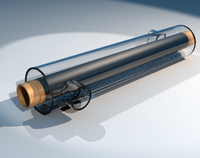
Photo from wikipedia
Abstract This paper attempts to fill a gap in the literature on ground heat exchanger sizing tools which are routinely used but have not been recently compared against each other.… Click to show full abstract
Abstract This paper attempts to fill a gap in the literature on ground heat exchanger sizing tools which are routinely used but have not been recently compared against each other. First, a comprehensive review of the governing equations of these tools is presented. The tools are then classified into five levels ( L 0 to L 4 ) according to their level of complexity from tools based on rules-of-thumb ( L 0 ) to those using annual hourly simulations ( L 4 ). Then this study presents a methodology for comparing vertical ground heat exchanger sizing tools. After a review of available tests, four test cases are proposed to cover the full spectrum of conditions from single boreholes to large bore fields with various annual ground thermal imbalances. This is followed by an inter-model comparison of twelve sizing tools including some commercially-available software programs and various forms of the ASHRAE sizing equation. In one of the tests on a single borehole subjected to a 1-h peak load duration, it is shown that the minimum and maximum lengths obtained by the various tools are 39.1 m and 59.7 m. Tools that include short-term effects tend to calculate smaller lengths while longer lengths are predicted by tools that evaluate effective ground thermal resistances using the cylindrical heat source solution. In another test involving a large annual ground imbalance on a 5 × 5 borehole field, it is shown that results vary from 93.0 m to 128.9 m among the twelve tools. A group of seven tools, including L 2 , L 3 , and L 4 tools are in good agreement with a minimum of 121.0 m and a maximum of 128.9 m. Two tools have determined lengths that are much lower than the rest of the tools (103.9 and 93.0 m). Clearly, these two tools cannot properly account for borehole thermal interaction caused by large annual imbalanced loads.
Journal Title: Renewable and Sustainable Energy Reviews
Year Published: 2019
Link to full text (if available)
Share on Social Media: Sign Up to like & get
recommendations!